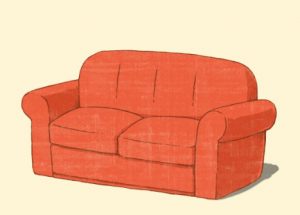 Writing a history of seating raises the problem of nomenclature. Take the couch, for example. The Greeks and the Romans dined on couches, which were really more like beds, which may be why the word derives from the French coucher, to lie down, although to complicate matters the French don’t call a couch a couche, but rather a canapé. (You can use that word in English, if you want to be fancy.) Midwesterners used to call couches davenports, after the Massachusetts company that manufactured them. When I was growing up in Canada, we called a couch a chesterfield, a Britishism which has since gone out of fashion. The term is said to have derived from the fourth Earl of Chesterfield, who commissioned a heavily tufted leather couch in the eighteenth century. Couch or sofa? Sofa is a Turkish word, so is ottoman, although the latter is now commonly used to refer to a footstool. Couch seems to have prevailed; we say “casting couch” and “couch potato,” and psychiatrists have couches, not sofas. Sofas seem to be more domestic, which may be why a couch that converts into a bed is called a sleeper sofa or a sofa bed. Go figure.
Writing a history of seating raises the problem of nomenclature. Take the couch, for example. The Greeks and the Romans dined on couches, which were really more like beds, which may be why the word derives from the French coucher, to lie down, although to complicate matters the French don’t call a couch a couche, but rather a canapé. (You can use that word in English, if you want to be fancy.) Midwesterners used to call couches davenports, after the Massachusetts company that manufactured them. When I was growing up in Canada, we called a couch a chesterfield, a Britishism which has since gone out of fashion. The term is said to have derived from the fourth Earl of Chesterfield, who commissioned a heavily tufted leather couch in the eighteenth century. Couch or sofa? Sofa is a Turkish word, so is ottoman, although the latter is now commonly used to refer to a footstool. Couch seems to have prevailed; we say “casting couch” and “couch potato,” and psychiatrists have couches, not sofas. Sofas seem to be more domestic, which may be why a couch that converts into a bed is called a sleeper sofa or a sofa bed. Go figure.
On Culture and Architecture

Couch or Sofa? Could we use physical characteristics of either historic form to help sort current styles? Was a sofa lower to the ground? Was a couch upholstered more thoroughly?
Is there an old – ancient? – furniture form that was referred to as an ottoman?